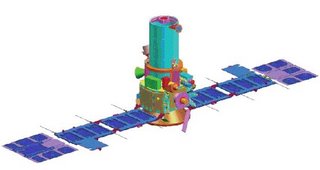
Frequencies for Wallops at end of list.
The Air Force Research Laboratory's TacSat-2 satellite is scheduled for launch Dec. 11, 2006, from the NASA Wallops Flight Facility. The U.S. Air Force Space and Missile Systems Center's Space Development and Test Wing has overall management of the mission. The satellite will be launched on an Air Force four-stage Minotaur I space launch vehicle contracted through Orbital Sciences Corporation's Launch Systems Group. The mission will be conducted from the Mid-Atlantic Regional Spaceport launch pad on the south end of Wallops Island.
TacSat-2 will be launched on board a Minotaur I rocket, integrated by Orbital Sciences Corporation (OSC). The Minotaur I is a four-stage vehicle, two stages being refurbished Minuteman II stages and the other two stages being OSC stages. The Minotaur is 69 feet tall and 5 feet wide.
The main payload is the TacSat-2 satellite which will exhibit tenets of responsive space concepts.
The secondary payload is the GeneSat-1, which was developed by the NASA Ames Research Center. GeneSat-1 is a fully automated, miniature spaceflight system that will provide life support for small living things. The mission will look for genetic changes in bacteria (E.Coli) during spaceflight. The E.Coli on board is E.Coli K-12, which cannot live within humans. The knowledge obtained from the GeneSat-1 experiment may contribute to safe, long-duration space missions by humans.
The TacSat-2 satellite carries on board a new technology instrument sponsored by the NASA New Millennium Program which develops and validates in space advanced technologies. The instrument, called the Inertial Stellar Compass (ISC), is part of the Space Technology 6 project. The ISC was developed by Draper Laboratory in Cambridge, Massachusetts. The ISC is a miniature star camera and MEMS gyro suite which will allow future small spacecraft autonomously find its orientation in space.
There are several ways to follow the countdown on launch day:
760 AM: The NASA Wallops Flight Facility Radio Station. (Note: This station only airs approximately 5-10 miles from the NASA Visitor Center.)
The Wallops Flight Facility website (http://www.wff.nasa.gov/index.html) will provide a running status of the launch countdown.
Local radio stations (103.3 WESR, 99.3 WVES, 99.9 WWFG, and 96.5 WCTG) will provide launch updates.
From our NASA Frequency and Callsign List (Note to our readers: A new expanded edition of our Monitoring NASA and Space Communications publication will be posted and available for download later today on the Monitoring Times website).
Wallops Island Flight Facility
Air-to-Ground Net 264.550 310.650 326.300 382.600
Approach/Departure Control 127.950 314.000 [Patuxent River Approach//Departure Services] 132.550 134.100 353.600 [Washington ARTCC]
ASOS Weather System 119.175
Clearance Delivery 121.700
Coordination Net 139.4750 140.2750
Distress, Safety and Calling (Marine) 156.8000
Earth Station Operations 166.0500
Facility Maintenance 171.3875
Flight Test Support 122.850 123.150 123.175 123.200 123.225 123.250 123.300 123.375 123.450 123.550
Instrumentation Net 149.1500 149.3250
Medical Net 171.0000
Miscellaneous Net 236.450 256.550
NASA Aircraft Operations 311.200
NASA Range Surveillance Aircraft/Mission Net 121.950 123.400
Paging System 170.4000
Security 170.3500
Test Range Operations 166.2250 171.1500 314.600
Test Range Safety 156.3000 156.6000 156.6250 156.7000 164.7000
Tower 126.500 394.300
Transportation Dispatch 46.7300
Unicom 122.800
TacSat-2 RF communications: CDL (Common Data Link) technology is being implemented (X-band downlink and uplink). AFRL is providing the first year of on-orbit operations. The most important contribution of TacSat-2 is the use of a space-based CDL. Flying a CDL transponder requires ground-breaking work in frequency allocations and communications security (COMSEC) approaches. Direct tasking and data dissemination are being implemented using the SIPRNet (Secret Internet Protocol Routing Network) capabilities, a classified network of DoD. The SIPRNet system objectives are to integrate all space assets into the forces so that the Joint Task Force (JTF) Commander can call up assets by deciding the payload capability required, i.e., the area of interest, the area for direct downlink, and the date the assets must be operational.
